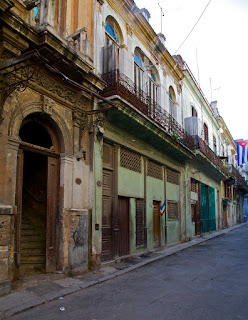 |
| Convent |
I have a photo of only a bit of this building (above) and I have included one of the square and buildings on the opposite side of the square from the convent, one of which we thought might have been a railway station. In this photo the convent is on the right. The near building on the left appears to be unoccupied, while the far one on the left and at least some of those at the end of the square seem to be family dwellings.
Left is the entry and stairway to an upstairs dwelling. While this entry has no doubt seen better days, it is clean and functional and, as we have seen, one must be careful about drawing conclusions about the living conditions based on the entry way as it does not necessarily reflect what lies beyond it.
The third photo taken along the same street shows extreme ruin, and, while this degree of structural collapse is by no means ubiquitous, evidence of significant decline is apparent in much of old Habana such that, to me (as I think I said before), the task of rejuvenation seems enormous.
On the way to our next objective, the Museo Casa Natal de José Marti (more about José Marti later), we came across a busy and colourful vegetable market with an abundance of enticing produce.
The flower stall here is just outside the vegetable market, shown in the photo below.
The array of both fruit and vegetables was impressive and, though we didn't buy anything, it was tempting. In addition to this kind of market there are also numerous vendors with carts of produce on the streets in both Havana and Cienfuegos.
In this photo (right), the woman sitting is selling plastic bags and on the right a bicitaxi driver is reclining while waiting for his next fare.
After the market we found the train station which we walked quickly through then on to the Capitolio, without finding the Museo Casa Natal de José Marti.
Immediately adjacent to the Capitolio is the exquisite 2000 seat Gran Teatro de Habana which Cuba claims to be the oldest functioning theatre in the western hemisphere. As I hope the photos tell, the architecture is quite spectacular.
 |
| Gran Teatro de Haban |


From the Teatro we walked down the Prado to the Hotel Sevilla for drinks in the courtyard, then to the roof for the view and some photos including a bird's eye view of the Prado which I think I showed in an earlier blog.
Then down Calle Obispo to the market near our hotel where I picked up a small gift for Ruth. For lunch we went to an upstairs bakery, Santo Domingo, which is recommended by the Lonely Planet guide. The food was fine but neither the food or the ambience was special,
 |
| Plaza de Catedral de San Cristóbal |
 |
| Catedral de San Cristóbal |
 |
| Plaza de Catedral de San Cristóbal |
From the plaza we set out for the hotel when we heard band music and crowd noise which sounded like it was nearby - we turned onto the next street and found a boisterous, colourful and somewhat loosely organized parade of people in a mix of bright costumes and street clothes, with banners and mucho music!
In the midst of all the activities as we stood along the edge of the street, a woman in bright yellow came very purposely toward us and I grabbed a photo of her approaching. She went directly to Bob, put her arm around him and kissed him on the cheek! This is definitely one of my favourite photos from this visit to Cuba.
Though we tried to learn about the reason for this parade, we were unsuccessful.
Back at the hotel a bit later, Bob discovered that his new camera would not turn on. He had had a bit of difficulty earlier in the day when it seemed to freeze after he had taken a few photos and nothing he could do would turn it off. So, he removed and replaced the battery and that seemed to fix it, but in hind sight it would appear that it was the beginning of the end for the camera. Very distressing! Fortunately he still has his iPhone which is equipped with a pretty good camera.
After a bit of rest we decided on a restaurant near our hotel, La Imprenta, which was recommended by the Lonely Planet guide. And it met expectations - the food was both good and of manageable size and, except for our slightly irascible waiter and the less than comfortable wooden chairs, the ambience was also very pleasant.















No comments:
Post a Comment